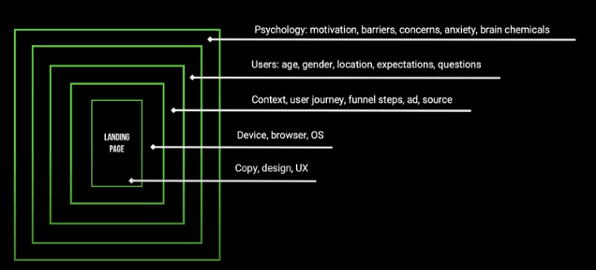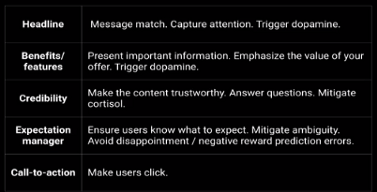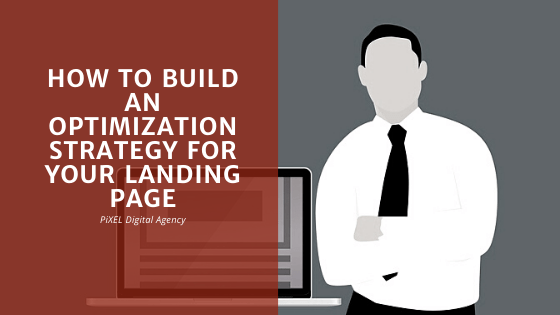- Which are the characteristics of a landing page
- The optimization process of a landing page
- Wireframing and information hierarchy in a landing page
- Quantitative research using Google Analytics
- Landing page copywriting fundamentals
You want to create an effective landing page that converts. For that reason, this is an in-depth analysis of which is the basic structure of a successful landing page. We are talking here about basic aspects because regardless of the industry you are in, this information you can start applying it today.
Which are the characteristics of a landing page
- It allows you to shorten the journey from click to conversion.
- Follows up on “promises ” made in ad sources.
- Speaks to users motivations and addresses their pain points.
- Answers important questions regarding the product or service you are advertising.
- Creates a clear path to the conversion goal.
A landing page is not everything and it cannot work without a defined goal. Therefore a landing page is part of a bigger experience.

To get closer to your customer, the elements that your landing page should take into consideration are:

Motivation: You need to understand your users’ motivations, concerns, pain points and how your landing page is going to affect their decision-making process.
Users: Additionally you need to know your target audience demographics and questions and expectations they might have regarding your product or service.
Customer journey: Where in your customer journey your landing page fits.
Device: Where are your visitors seeing the site. Is on chrome, from a mobile device and which type of mobile device.
Copy, design, UX. Design and test what is your users’ behaviour and what makes them click on your website and Calls to Action.
The optimization process of a landing page
Now you know where the page fits into your marketing strategy, what elements it should contain and the characteristics of the landing page. Once you’ve mapped out your marketing campaign and decided you want to build a landing page you need to perform the following steps:
- Conduct research about your users, their pain points.
- Understand why they would come to your landing page and where from.
- Form/ Validate hypothesis to see how accurate your assumptions are.
- Create a solution depending on conclusions obtained from the research and hypothesis testing.
- Conduct experiments to test various hypotheses and landing page formats.
- Analyze experiment data and select the best option to launch as a definitive landing page.
- Conduct a follow-up experiment. This is about performing A/B test with small modifications and see the results.
This process never ends but you need to perform experiments until you reach an optimal point where further testing is going to be detrimental and inefficient.
Wireframing and information hierarchy
Wireframing is about creating a visual guide that represents the skeletal framework of a website. This is just for you to understand what steps to follow and what to focus on when creating your page. There are some benefits to it as well. By wireframing you can:
- Visualize the landing page earlier on instead of seeing it down the road and detect major issues.
- Prioritize content and build an accurate structure from the beginning.
- Align in an easy way the copy and design.
A common questions businesses tend to ask is when information on a page is too much and when is just fine to launch it, And the answer depends on various factors and we can highlight service or product complexity and awareness.
Having a lot of information on your landing page is fine as long as it is relevant and served in a logical and concise way. Here the trick is to build one part at a time and test to see how it would react on the user.
We can also encounter 2 extremes in this situation. Too much information at once creates confusion and increases the chances of having a higher bounce rate. On the other hand, not enough information creates irritation and a higher bounce rate as well. For that reason, information hierarchy helps you find the right balance.
Quantitative research using Google Analytics
We recommend using an analytics tool to make a couple of tests to understand the overall performance. I guess at this point your landing page does not have so much traffic and analyze some basic parameters will help you see how your landing page is doing. You can therefore analyze:
- Overall landing performance
- Overall device performance
- Overall browser performance
- Traffic source, conversion rate, transactions, bounce rate
- Source, second page, exit page, gender, age
- Potential bugs
If you have some test users to see the landing page you can make them some questions after seeing it for no more than 5 seconds:
- What is your first impression of this step?
- How does it make you feel?
- Is there anything that stands out?
- Is it clear who the source is?
- Does the source seem credible?
Now if you were to do a detailed analysis you can go through all the content and answer the following questions:
- Is the information delivered in a logical order?
- Is the content structured in a logical order?
- Does anything seem confusing?
- Do you have any unanswered questions?
- Do you have a clear idea of what to do next?
- Is there anything you would add?
- Is there anything you would remove?
- Is there anything you would rearrange?
- Are there any UX issues?
- Are there any bugs/technical issues?
Landing page copywriting fundamentals
You need to build a landing page with your users in mind and understand their needs. Also taking into consideration which is their awareness level of your service or product. Is not the same information you are going to provide to someone who has not seen your product before or to someone who is aware to a certain extent of your solutions.
After clarifying the information mentioned above the 5 most important copy elements your website should include are:

Types of variables you need to define to make your landing page successful:
A clear message: basically you need to have a clear message that matches with the message your ad has. It is used to capture attention, trigger dopamine, make users stay. It should also communicate the value of your offer clearly.
Features and benefits
- Emphasize the value of your offer
- Answer important questions
- Test with different copy format
Credibility: include relevant facts and figures to help the visitor make a decision based on logical facts. Also, you can generate it with social proof and testimonials. Frequently asked questions are another way to establish credibility.
Expectations management: is about clarifying common questions or misconceptions your users might have about your service. This is part where you can give them more relevant information about your pricing for instance or details of your product customer must know.
Call to action: lastly, the call to action copy should:
- Motivate the user to click — trigger dopamine
- Give a clear idea of what happens when you click
- Be relevant to your conversion goal
- Start with a verb
- Focus on what you get — not what you part with
- Set realistic expectations
This extended article is to guide you through the complexities a landing page has. You can always test and ensure the quality of your page attracts the right audience.




